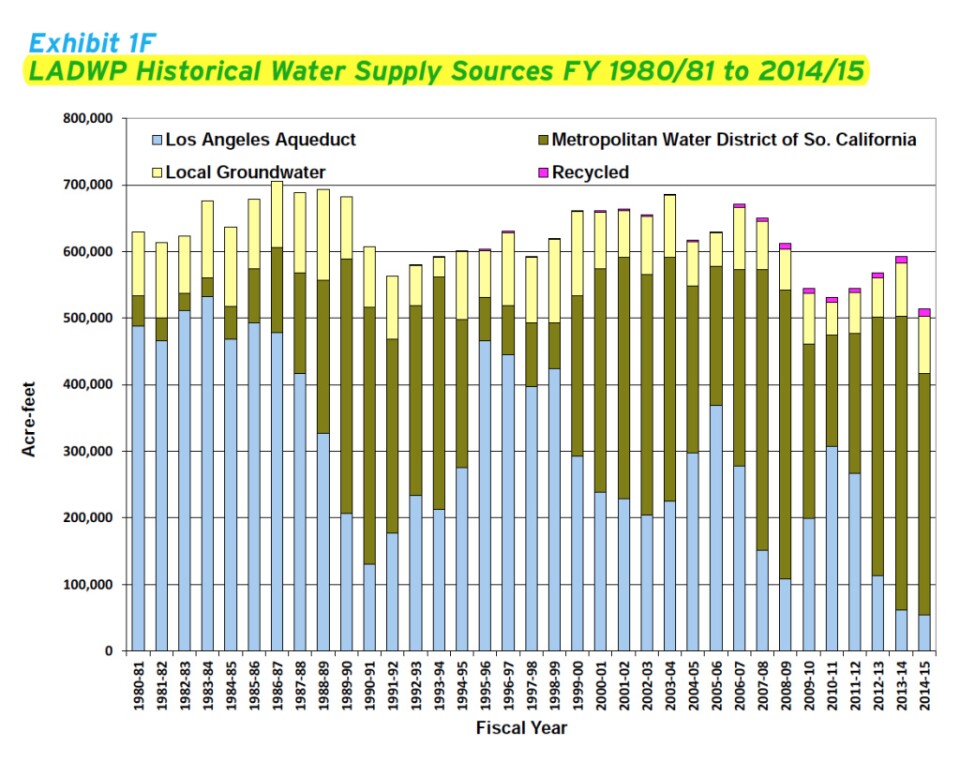With our free press under threat and federal funding for public media gone, your support matters more than ever. Help keep the LAist newsroom strong, become a monthly member or increase your support today.
The DWP board just approved new 25-year water use plan. Here's what's in it
Want to know where L.A. will get its water over the next 25 years? The Los Angeles Department of Water and Power says it has the answer. On Tuesday the board for the utility approved a new urban water management plan (UWMP). The city has had versions of similar plans in the past, but this one is drastically different. Before we get to how, let's cover some basics.
What exactly is an UWMP?
An Urban Water Management Plan is a phonebook-sized planning document that water agencies are required by state law to write every five years. It’s basically a roadmap of how and where the city will get its water over the next 25 years. DWP has had one in place since 1984.
What’s in it?
All kinds of things! Bar graphs showing where your water comes from, cool maps of all the tunnels and canals that get it here, pictures of rain barrels you can get to save water, etc. Probably the most important thing, though, are the projections of how much water DWP can access over 25 years under different rainfall scenarios.
What's behind the difference between wet and dry years?
In times of drought, DWP doesn’t get as much water from local sources, so it has to rely on imported water that comes from far away and that has lots of different water agencies competing for it.
Where does our water come from?

Locally, it comes from recycled wastewater, underground aquifers and captured stormwater.
Our imported water comes two primary sources. One is from the eastern Sierra Nevada via the Los Angeles Aqueduct, which the city owns. The second is purchases from the Metropolitan Water District, a regional wholesaler, which gets water from the Colorado River and Northern California.
On average, LA imports 87 percent of its water. But that’s expected to change under the new UWMP.
How?
LA Mayor Eric Garcetti has set a goal of getting half of the city’s water from local sources by 2035, and the new UWMP reflects that goal.
Is that possible?
It depends who you ask. DWP says yes – especially because the city has been doing a good job reducing per capita water usage over the past few decades. In 1970, L.A. had 2.4 million people and used 600,000 acre feet of water a year. Today, with 4 million people, it consumes just over 500,000.
“You don’t necessarily need a lot of water to meet the needs of a growing city,” said David Pettijohn, director of water resources for DWP.
The utility also has ambitious plans to get people to embrace recycled wastewater, treat contaminated groundwater the city currently has access to and build stormwater capture infrastructure.
But others are skeptical.
“To say, 'don’t worry about it folks, we’re going to have all this in place in 25 years and that will supply half all the water we use,' there’s no way we can predict that,” said Casey Maddren, who writes the local issue blog The Horizon and the Skyline. He sent DWP some critical public comments on the new water plan. “It’s irresponsible to let people believe that’s going to happen.”
Maddren points to the fact that – according to DWP’s own data – the agency has consistently projected a larger water supply than it actually receives. The gap between the two has grown over the years as LA's imported water sources have become less reliable. For example, half of the water that we used to get from the Los Angeles Aqueduct we now have to give back to the Owens Valley and Mono Lake to mitigate dust and other environmental issues. The five-year drought has also reduced the amount of water we get from the state aqueduct that brings water from Northern California.
“Psychologically, Angelenos have been conditioned to think the water’s always going to come from somewhere,” Maddren said, “and none of us want to think otherwise.”
So… do we have enough water or not?
This question gets at the fundamental purpose of these Urban Water Management Plans.
Critics like Maddren say the plans should guide sustainable growth by making sure the city is growing in a way that ensures we have enough water. He points to recent findings that wealthier neighborhoods in LA consume more water than less affluent ones. He wonders if the city should be building as much luxury housing.
“If we have a limited water supply, we want to prioritize the kind of development we put up," he said. "We should be building units for middle- and low-income people which is the best use of our water, I believe.”
But DWP’s David Pettijohn says his agency's job is to accommodate, not influence, new growth.
“Every department has its own responsibilities. The responsibility of the LADWP is to meet the resources of the city. It’s not our responsibility to control growth in the city,” he said.
Indeed, the state law requiring UWMPs sees the documents as planning tools to accommodate projected population growth.
According to DWP's new water management plan, the answer is yes, we should have enough water for the next 25 years – even under all kinds of drought scenarios and even with an additional 500,000 people. The unanswered questions are: how much will it cost? Will we really be able to get half of it from local sources? And if not, where will it come from?









